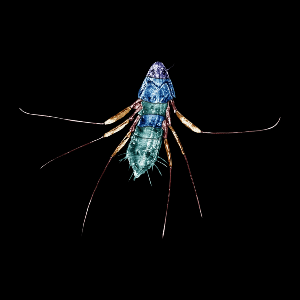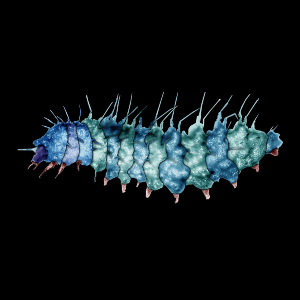Insects already had a variety of defense strategies in the Cretaceous
20 Dec 2023
Analyses of amber show that insect larvae were already using a wide variety of tactics to protect themselves from predators 100 million years ago.
20 Dec 2023
Analyses of amber show that insect larvae were already using a wide variety of tactics to protect themselves from predators 100 million years ago.

Larva of a wedge-shaped beetle in amber, which could have lived inside other insects like its modern counterparts. | © Carolin Haug
Early life stages of insects fulfill important functions in our ecosystems. They decompose dead bodies and wood, forming soil and returning various elements into material cycles. Not least, they are a major food source for many larger animals such as birds and mammals. This has led to many insect larvae developing structures and strategies for reducing the danger of being eaten. These include features like spines and hairs, but also camouflage and concealment. Over millions of years, a wide variety of such adaptation strategies have developed.
Researchers at LMU and the universities of Greifswald and Rostock have studied particularly well preserved fossils from Burmese amber and have been able to demonstrate that such anti-predator mechanisms had already evolved very diverse forms in insect larvae during the Cretaceous period 100 million years ago. This includes well-known strategies such as that employed by lacewing larvae, which carry various plant and animal materials on their back to give them camouflage, or the ploy of mimicking the appearance of certain plant parts.

Larva of a scorpionfly in 100-million-year-old amber with hairs on its back for attaching camouflage material. | © Carolin Haug
“A particularly spectacular example is by far the oldest larva of a scorpionfly to have been discovered, which is the second fossil ever found to have special hairs on its back for attaching camouflage material,” says Professor Carolin Haug, lead author of the article and zoologist at the Faculty of Biology. “Also, I could mention sawfly larvae that lived in leaves and created tunnels in them as they ate their way through the thin layer of the leaf interior.” Overall, the article, which has been published in the journal iScience, shows that a large variety of different strategies already existed 100 million years ago for insect larvae to defend themselves against predators. “Observing the diversity of the past and the emergence and disappearance of various morphologies helps us better understand these processes, which is particularly important in view of the ongoing biodiversity crisis,” says Haug.
Carolin Haug, Joachim Haug, Gideon Haug, Patrick Müller, Ana Zippel, Christine Kiesmüller, Joshua Gauweiler & Marie K. Hörnig: Fossils in Myanmar amber demonstrate the diversity of anti-predator strategies of Cretaceous holometabolan insect larvae. iScience 2023